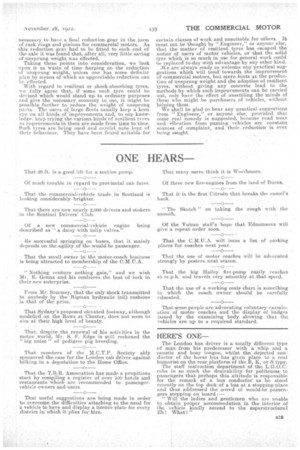Unsprung Weight.
Page 2

Page 3

If you've noticed an error in this article please click here to report it so we can fix it.
ALETTER appears in the issue of The Commercial Motor for November 14th from "Engineer," which follows on many others dealing with the above subject. There seems to be an idea that, a designer could, if he chose, very+ considerably reduce the weight of unsprung parts of a commercial motor. It is not very clear in what way " Engineer " proposes to 'do this and his reference to "shock absorbing tyres" do not help much. He describes a tyre which Will " give " i in. under normal load and 2 in. under maximum load. Ho points out the difficulties of attaining this with solid tyres, with which we entirely agree. If we are right this brings us to the conclusion that " Engineer " is referring either to cushion or pneumatic tyres. Both these kinds of tyres have and are being used for commercial motors, and for certain purposes have undoubtedly proved themselves useful. It is obvious, however, that the fitting of pneumatic or cushion tyres cannot be advocated as a rule which would apply to commercial . motors generally. " Engineer" must have but a poor opinion of the engineers of bus companies and firms owning large fleets if he thinks they still cling to solid tyres from want. of knowledge or "sheer cussedness." It is not wise to think that such men. have not investigated the merits of all kinds of tyres. B18
" Engineer " is probably not aware of the huge sums spent annually by certain eompanies, in experimental and research work in connection with tyres and, every part of the commercial motor.
We have noticed a great many mysterious references to " resilient" tyres and "reduced weight of unsprung parts," which would lead the public to believe that our designers are either ignorant or too conservative to avail themselves of what is in front of them, clinging to old-fashioned methods when the right thing can be had for the asking. The matter of reducing unsprung weight has received the attention of designers for years, and if it were possible to reduce the weight of such parts by any appreciable amount it would have been done long ago. The back axle is a most"vital part and one which has received from designers probably MOTO attention than any one part of the chassis. So difficult has it proved to construct a back axle which will fulfil all the requirements, that its design: is even now one of the most debatable points that are left. Efforts have been made to reduce weight of unsprung parts by attaching the differential to the chassis and having a weight carrying axle of sufficient strength to support the wheels, and connecting the drive by means of short cardan shafts fitted with universal joints at each end With this class of construction it was found necessary to have a final reduction gear in the form. of rack rings and pinions for commercial motors. As this redidetien gear had tor be fitted to each end of the axle it was found that, after all, very little saving of unsprung weight was effected.
Taking these points into consideration, we look opOn it as waste of time harping on the reduction of unsprung weight, unless one has some definite plan by means of which an appreciable reduction can be effected.
With regard to resilient or shock-absorbing tyres, we fully_ agree that, ifsome such tyre could be devised which would stand upto ordinary purposes and give the necessary economyin use, it might be possible further to reduce the weight of unsprung parts. The users of large fleets usually keep a keen eye on all kinds of improvements and, to our knowledge: keep:trying.66...various kinds -of resilient tyres as improvements in them are made fromtime to time.
• Such tyres are:b.eing used and _careful note kept of their behaviour. They have been .fouth.I suitable for certain classes of work and unsuitable for others. It must not be thought by " Engineer," or anyone else., that the matter of resilient tyres has escaped the notice of users of motor vehicles, or that the solid tyre which is so much in use for general work could be replaced to-day with advantage by any other kind. -We are always ready to welcome any practical suggestions which will tend' towards the improvement of commercial motors, but mere hints at the production of unsprung weight and the adoption of resilient tyres, without giVing, any concrete lead to the methods by which such improvements can be carried out, only have the effect ofunsettling the minds of those who might be purchasers of vehicles, without helping them.
We shall be glad -to hear any practical suggestions from " Engineer," or anyone else, provided till-it some .real remedy is suggested, because road wear and vibration from 'Passing vehicles are constant sauces of complaint. and their. reduction is ever being sought




























